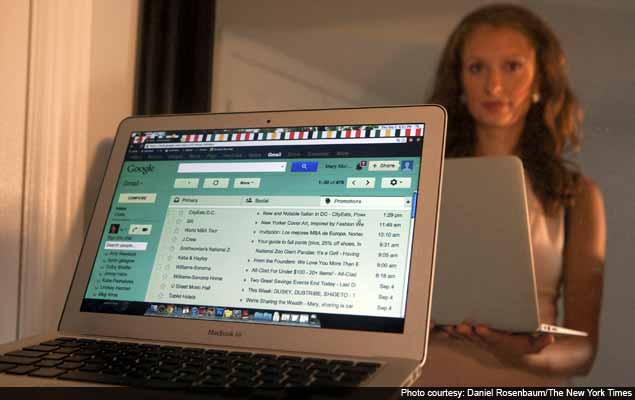- Home
- Internet
- Internet News
- For retailers, new Gmail has one tab too many
For retailers, new Gmail has one tab too many

Over the summer, the Internet behemoth gradually introduced a new inbox with an assortment of folders for different types of messages, including a main inbox and ones for social networking alerts, ecommerce promotions, updates from businesses like banks and Listserv messages.
For Google, it's another moneymaking avenue (note the ads that look like emails that now appear at the top of the promotions folder). Also, the company says it wants to fix email overload.
Yet any tiny change that the Internet giant makes has cascading effects for businesses across the Web.
"I don't like it," said Ada Polla, chief executive of Alchimie Forever, a skin care brand. "My guess would be that you might log on to your Gmail 20 times a day, and look at promotions once a week."
Retailers, who have a love-hate relationship with Google, say this is the latest tussle in an increasingly contentious union. Google, they say, has effectively classified their messages as junk mail by shunting them to an inbox ghetto.
It is too early to tell exactly how Gmail users treat the new tabs, because Google is still rolling out the feature. Although retailers fear that fewer customers are clicking on their sites - because they didn't read the email promising 40 percent off - so far, there has been only a small effect. The rate at which consumers open e-commerce emails has declined about 1 percent since it was introduced, according to three services that manage mass emails - Yesmail Interactive, MailChimp and 3DCart.
Another change, though, might be more worrisome for e-commerce companies. While shoppers typically click on promotions within hours of receiving an email on other services like Yahoo and Outlook, Gmail users are waiting more than 24 hours, 3DCart said.
That is problematic for flash-sale sites, like Gilt and MyHabit, whose business depends on drawing customers to limited-time sales.
"One of our limitations is we're a flash site that starts our sales at noon, so that's the primary way that we communicate with our members, through email," said Elizabeth Francis, Gilt's chief marketing officer.
Retailers also say the changes don't apply to every business; Google's own marketing messages from Google Analytics and AdWords have been appearing in the primary inbox - belying the company's argument that the promotions folder is vibrant.
But Alex Gawley, a Gmail product manager, said that there was "no special treatment" for Google's own promotional emails, and that the algorithm was still learning how emails should be categorized.
"You'll see it get more and more accurate and you'll probably see those types of emails moving to the place where people expect them to be," he said.
Companies, including Gap and Groupon, are resisting the changes by begging customers to move their messages back to the primary inbox. Gilt has been putting banners atop daily emails that say, "Drag and drop me into your Primary tab!" If people do that, future emails from the same sender will appear there. Gmail users can also turn off the sorting by changing their inbox settings.
Gilt does not know whether its campaign is working, Francis said, because Google does not provide information about how customers move their email around.
Retailers have little choice but to use Google, whether buying search ads or sending inventory feeds to Google's comparison shopping service. But they complain that Google has been complicating the relationship in various ways. Last year, for instance, it began charging retailers to appear in its product search, leading some, including Amazon, to remove their listings from the service.
The change to Gmail, though, strikes at the heart of retailers' marketing tactics. Eighty percent of marketers are investing more in email this year than last, according to a study by Forrester Research and Shop.org. And with nearly half a billion users, Gmail is a major part of that strategy.
Although Google is also filtering other messages into secondary inboxes, like sending Twitter and LinkedIn notifications to the social tab, retailers say they have the most to lose.
Email marketing is vital to her business, Polla said; she too has urged customers to move Alchimie's emails back to the primary inbox.
"I worked so hard to get it, I want to make sure that I'm able to utilize it," she said of her email subscription list.
Google made the change, Gawley said, because email had become a headache for most people, in part because so many types of mail compete for attention. Who has not missed an important email from a friend because it was lodged between clearance-sale messages?
The problem is even more acute on mobile devices. People checking email on small screens have less patience for scrolling through unwanted messages. Retailers say that on average, 28 percent of emails sent to customers are first opened on a smartphone, the Forrester and Shop.org study found. Google has started to address this by segregating email into tabs for people who use a Gmail mobile application.
"Our goal with the new inbox was really to help users stay on top of everything that's coming into their inbox," Gawley said. "It was difficult to parse this list when messages of very different contexts were all kind of intertwined."
To prevent the secondary in-boxes from becoming unread folders of junk mail, Google has designed the tabs to alert people when new messages appear there, he said. The hope is that the promotions tab encourages people to pay more attention to marketing emails, he said, because they will peruse those messages when they are in the mood to shop, rather than discarding messages that interrupt their day.
And, Google hopes, they will also pay more attention to the new ads Google is showing there.
"By creating the promotions tab, we created a context in Gmail where users are in the commercial mindset," Gawley said.
Some Gmail users say they like the change, and are paying more attention to marketing emails.
Mary Morgan, 23, who works in public relations in Washington, said she used to delete marketing messages when they interfered with her daily tasks, but now set aside time to read them. "I love that Gmail has figured out a way to automatically put everything into different tabs for me," she said.
Pam Bullock, 27, a business consultant in Kettering, Ohio, is getting fed up with pleas from retailers to move their messages into in-boxes - Ann Taylor, Newegg and Rent the Runway are among those who have issued such requests to her.
"It's palpable, and it gives me anxiety," she said. Still, she said she had been looking at promotions less frequently, and "that's where I feel like they are a little validated."
© 2013, The New York Times News Service
Get your daily dose of tech news, reviews, and insights, in under 80 characters on Gadgets 360 Turbo. Connect with fellow tech lovers on our Forum. Follow us on X, Facebook, WhatsApp, Threads and Google News for instant updates. Catch all the action on our YouTube channel.
Related Stories
- Samsung Galaxy Unpacked 2025
- ChatGPT
- Redmi Note 14 Pro+
- iPhone 16
- Apple Vision Pro
- Oneplus 12
- OnePlus Nord CE 3 Lite 5G
- iPhone 13
- Xiaomi 14 Pro
- Oppo Find N3
- Tecno Spark Go (2023)
- Realme V30
- Best Phones Under 25000
- Samsung Galaxy S24 Series
- Cryptocurrency
- iQoo 12
- Samsung Galaxy S24 Ultra
- Giottus
- Samsung Galaxy Z Flip 5
- Apple 'Scary Fast'
- Housefull 5
- GoPro Hero 12 Black Review
- Invincible Season 2
- JioGlass
- HD Ready TV
- Laptop Under 50000
- Smartwatch Under 10000
- Latest Mobile Phones
- Compare Phones
- Realme P4x 5G
- OnePlus Ace 6T
- Nubia Flip 3
- Nubia Fold
- OPPO A6x 5G
- Samsung Galaxy Z TriFold
- Poco F8 Ultra
- Poco F8 Pro
- Asus ProArt P16
- MacBook Pro 14-inch (M5, 2025)
- Poco Pad M1
- Poco Pad X1
- Just Corseca Skywatch Pro
- Honor Watch X5
- Acerpure Nitro Z Series 100-inch QLED TV
- Samsung 43 Inch LED Ultra HD (4K) Smart TV (UA43UE81AFULXL)
- Asus ROG Ally
- Nintendo Switch Lite
- Haier 1.6 Ton 5 Star Inverter Split AC (HSU19G-MZAID5BN-INV)
- Haier 1.6 Ton 5 Star Inverter Split AC (HSU19G-MZAIM5BN-INV)
















